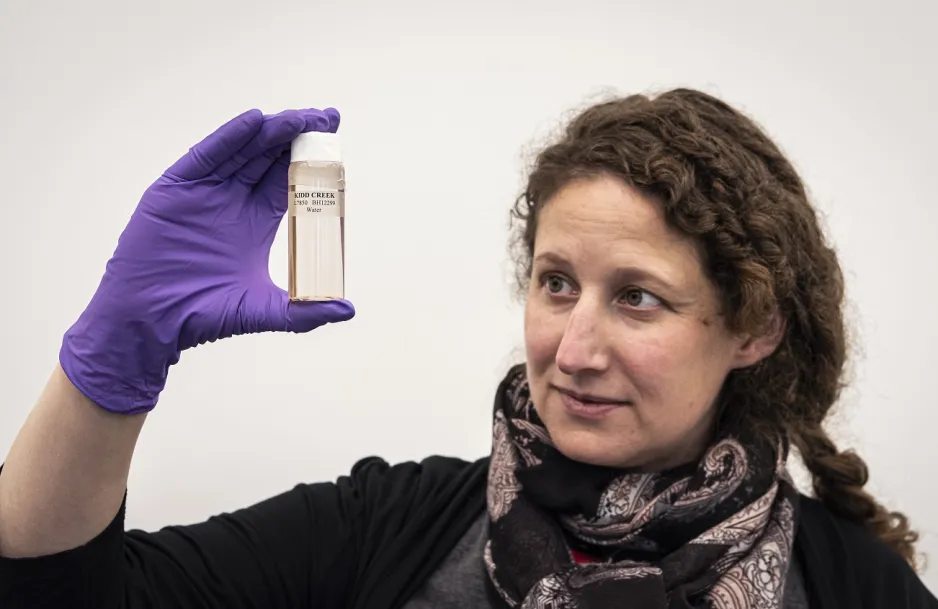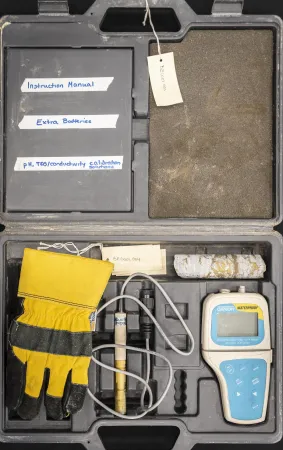Messages in a bottle: Ancient water in the Ingenium collection

When I was little, I often imagined that the sun’s sparkling reflection in lakes, rivers, and puddles was some kind of message, a mutating hieroglyph, a story that I did not know how to read. Yet somehow I knew that water was imbued with memories.

The author at age five, sitting on the dock at Seba Beach, Lake Wabamun, Alberta, circa 1985.
As I grew older, I learned about the hydrologic cycle, how water circulates and moves through the hydrosphere — the air, the Earth, and the seas. Water is ubiquitous — it covers over 70 percent of the Earth’s surface and constitutes up to 60 percent of human bodies — and yet its depths are often overlooked. Have you ever sat with a clear glass in front of you and wondered about the water molecules: Where were they before? Where are they going next? How does water connect us to our environment, and to each other? What does water remember? As the Curator of Natural Resources and Industrial Technologies for Ingenium, I’ve often contemplated these questions.
While all water circulates, sometimes groundwater can reside or stay within the Earth’s crust for many years. Scientists used to think that the oldest water on Earth, the water with the longest residence time, was about 100 to 200 million years old. This would mean that the water had been underground since the Mesozoic Era, perhaps during the Jurassic or Cretaceous Period, the time of the dinosaurs, when mammals and birds — that we would recognize from museums or movies — roamed the Earth’s surfaces. However, in 2009 something extraordinary happened...

A poster of Barbara Sherwood Lollar, created as part of the Ingenium Women in STEM initiative.
A message from the deep
When University of Toronto geochemist Dr. Barbara Sherwood Lollar and her research team were approximately 2.4 km below the Earth’s surface, in the Kidd Creek Mine near Timmins, Ontario, they collected what was later proven to be the oldest-known flowing water on Earth.
Upon returning to her lab, she and her colleagues traced many lines of evidence that both investigated the water’s geochemical and radiogenic fingerprints, and analyzed the sulfate-reducing, rock-eating microbes that live in the highly saline groundwaters.
This evidence led to the conclusion that the water’s mean residence time was more than a billion years — from the Precambrian era! Some components of the water are older yet: this ancient water bears witness to the time before the great oxidation event, before the Earth drew its first breath.

The geologic time spiral: A path to the past
Check out the image gallery below, featuring photos taken by Dr. Barbara Sherwood Lollar and her research team in the Kidd Creek Mine.
Although miners had long been aware of underground water, the collection and scientific analysis of both the free-flowing fracture fluids and the microbes living within it is significant for many reasons. These include: a deepening of our understanding of the hydrosphere, and an increasing of our knowledge about the capacity for life to occur in extreme conditions. This discovery gives us clues as to the potential for life that is buried within the deepest parts of other planets. But this water also compels us to ask questions about our relationships, both with water and with the experience of geologic time, in which the Anthropocene — the geological era in which we are currently living that is defined by human’s impact on the environment — appears as a brief moment. Like ancient rocks, this water brings messages from the Earth’s early days.

Rebecca Dolgoy, Ingenium’s Curator of Natural Resources and Industrial Technologies, holds a tiny vial filled with ancient water.
Reading and responding
In February 2020, Dr. Sherwood Lollar and the University of Toronto transferred a silicate glass bottle of this ancient water to Ingenium’s care. In addition to the water sample, which is now one of the oldest museum artifacts in the world, Ingenium also received a sample of the type of rock that the chemolithotrophic (literally “rock-eating”) microbes in the water "eat," and several items that were used in the collection and analysis of the water sample. See a gallery of these images below.
Looking closely at the bottle, your eyes are drawn to the yellow-looking sediment at the bottom of the vial. When agitated, the golden swirls are reminiscent of the spiral of geologic time or the DNA’s molecule’s double helix, which makes sense, because this water emblematizes the Earth’s DNA. Analysis showed that there were a variety of things in the water including: tiny organisms and the hydrogen and sulfate that these organisms ate. Though we have not opened the bottle, Dr. Sherwood Lollar has assured us that the water smells like sulfate and that it tastes extremely salty, as this ancient water has about three to 10 times the salinity of sea water. (In case you are curious about it — the way I was! — the professor explained that while she and her team did not deliberately drink the water; droplets splashed on the researchers’ skin and equipment while they were underground).

Swirling water
Caring for the water at Ingenium goes beyond our ability to physically look after it. Stewardship means providing access; it means engaging with partners who bring multiple knowledge and experiential perspectives to the water. Finally, it means reflecting on this water — but more broadly on water as a precious resource. We are humbled to be the caretakers of this water, and we will endeavour to find so many ways to share it with you, to listen to your thoughts, and to do our best to read and respond to the messages in this tiny bottle.
Video
Watch the short video below to hear Ingenium’s Curator of Natural Resources and Industrial Technologies Rebecca Dolgoy, as she discusses Ingenium's acquisition of the billion-year-old water sample.
Transcript
Ingenium acquires oldest-known flowing water
Go further
• “The Oldest Water on Earth”: English podcast from Third Pod from the Sun (2018).
• “Deep fracture fluids isolated in the crust since the Precambrian era”: English article in Nature (2013) (Subscription required).
• “NSERC Presents Two Minutes with Barbara Sherwood Lollar”: English video from NSERC (2016).
• “Massey Dialogues: Dr. Barbara Sherwood Lollar on Earth Research that Matters for Life on Other Planets”: English video from Massey College (2020).
• « Un prix national pour celle qui a découvert la plus vieille eau au monde… à Timmins! » : French interview with Barbara Sherwood Lollar on Le matin du nord, Radio Canada (2019).
• Entre nous: French TV interview with Barbara Sherwood Lollar on tv Rogers (2020).
• “Médaille d’or Gerhard-Herzberg en sciences et en génie du Canada”: English video with French subtitles from NSERC (2019).
























